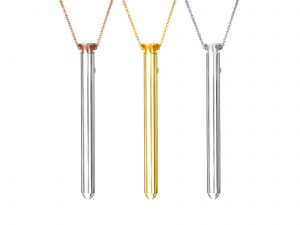(Hidden) Sex Toy Design: The Vesper Necklace
Maaike Taekema
The sex toy market is enjoying unprecedented growth in recent years due to increased social acceptance and entertainment industries incorporating the current trend into their fields.1 With the proliferation of adult products in the market over the last five years, consumers have enjoyed the benefits of anonymity, lower prices, and more options.2 And among the increasing industry of adult paraphernalia, there is an emerging niche market of “hidden” sex toys. These objects are deliberately designed to be multifunctional objects and thereby pose interesting questions regarding the object’s interaction with the body and its intended function. Is the object perceived the same way during both uses? Are both equally important and perceived as such? Moreover, do all people interact with it the same way?
As Carolyn Thomas, professor of American studies at the University of California, Davis, stated in her essay “The Saccharin Sparrow (Circa 1955),” the interaction with the human body takes on cultural meaning only through this particular encounter: “Because they require an intense physical connection in order to ‘work,’ and because the connection can effectively merge material and self for the user, these objects must be considered equal parts ‘stuff ’ and sensation.”3 Thomas used the term “experiential material culture” to decode the meaning of the object. Although she points out, “when engaging body objects one also needs to undertake a bodily engaged analysis,” this term fails to include the user’s perception as well as the envisioned use and effect of the creator in order to decode the true meaning of the object.4
In order to properly understand “hidden” sex toy design and what is represents, it is essential to also incorporate the individual perception and the designer’s intended use/experience. Art historian Jules D. Prown has said, “objects made or modified by man reflect, consciously or unconsciously, directly or indirectly, the beliefs of individuals who made, commissioned, purchased, or used them.”5 Prown suggests that these artifacts are—in addition to their intended function— unconscious representations of the hidden mind of belief.6 The information of an object, besides the information given by the object itself, is labelled by Prown as “external evidence” and is based on subjectivity (e.g. emotional and psychological responses, customs, rituals, etc.)7 Although this does provide valid and essential information, it should be understood that by analyzing the subjective aspects of an object, we are biased by our own personal background, beliefs, and perception. In other words, there is never an absolute truth about an object’s design and impact, but rather a cultural understanding of its meaning.
In this article, the Vesper Vibrator Necklace will be used as a case study to demonstrate the importance of analyzing the object’s subjectivity and to understand the duality of hidden sex toy design.
The Vesper
Designed by Crave, the Vesper looks like a piece of jewelry but also functions as a vibrator. The necklace is available online in three finishes—silver, rose gold, and 24k gold-plated—and is priced from $69 to $149. It forms a sharp contrast to the typical male genitalia-shaped vibrators made of materials such as silicone, plastic, or cyberskin that run on batteries. The Vesper was designed in cooperation with a goldsmith, charges via USB port, and looks like a sleek pendant.
The object consists of two components, namely the necklace itself, which measures approximately 24 inches, and the pendant, which looks like a pencil in the sense that it is long, cylindrical, and has a narrowed end. The pendant and necklace are not detachable, but the cap of the pendant can be unscrewed, separating the components. Both the chain and vibrating pendant are made of stainless steel. The company’s name is discreetly engraved on the top of the cap: CRAVE. There is also the option to inscribe a personal message.
Figure 1. Vesper Necklaces designed by Crave: rose gold, 24k gold-plated and silver. © 2013 Crave Inc.
The rather ingenious mechanism inside the Vesper is designed to be completely silent, granting more freedom and ease of use.8 It has also been developed to warm up when in use: the stainless steel material functions as a transmitter of the warmth that is released by the vibrating/pulsating mechanism inside. Another characteristic feature of stainless steel is that it is not affected by liquids, which makes it easy to clean with a damp cloth and suitable for use given the object’s use for both adornment and sexual pleasure. Furthermore, because the Vesper does not use batteries, but is rechargeable by USB, the design can adapt to a slimmer body, in contrast to battery-operated vibrators. The USB-charger is a small cable which makes it easy to carry and stow in a small compartment, such as a purse. Moreover, because of the slim, lightweight design and the high quality materials used, the Vesper rightly qualifies itself as jewelry—granting the user the freedom to choose how and where to use it.
Hidden Sex Toy Design
Can we interpret this vibrator as “hidden” in a jewelry piece and is there a particular reason for this distinctive design? Michael Topolovac, CEO of Crave, says that the reason for this design was because of a gap between the quality experiences women seek and what was available on the market.9 This lack of high-end sex toys can be explained by the cultural perception and stigma surrounding female masturbation.
Historian and sexologist Thomas Laqueur writes in his book, Solitary Sex: A Cultural History of Masturbation, about the taboos and cultural perceptions of sex from the 17th century up until the present. Laqueur states that solitary sex was not much of an issue for several millennia, until the 18th century, when masturbation was linked to physical and mental illness and not “approved of ” by God.10 It was not until the 1960s that solitary sex was “commonly” perceived as healthy via academic journals, spiritual self-realization, and liberation from a repressive heterosexist regime.11 The focus on female sex toys such as dildos and vibrators initiated a decennium later when female masturbation was seen as a statement of feminism and/or lesbian rights.12 This feminism and sexual liberation found support in literature (especially novels) and gained popularity in the late 1980s. However, it was not until the ‘90s that sexual and artistic trends, due to media such as photography and film, slowly changed from the depiction of women as objects of sexual desire toward the focus on women’s desirability.13 At the same time, an American cleric declared masturbation approved by God since sex is an essential part of the human being.14 Furthermore, Laqueur states, “Old paradigms die hard,” implying that the acceptance of female masturbation and the novelty of sex toys will need some time to be accepted.15

Figure 2. Necklace with engraved cap and detachable “Vesper,” showing a silicone power button used to select one of four speeds. © 2013 Crave Inc.
The recent book and Hollywood film Fifty Shades of Grey by E L James caused quite a stir worldwide in its sexual explicitness and use of sex toys. However, the movie was one of Hollywood’s biggest blockbusters and generated a substantial sales boost for the sex toy industry, especially for one specific item referenced in the novel, the Kegel Balls, of which one million units were sold in six months.16 These mainstream mediums, book and film, have reached a broad audience and have influenced their public. Nevertheless, it would be rather utopian to think that these mainstream successes can diminish the entire stigma around female masturbation despite the amount of people they reach worldwide.
According to David Rosen, a public affairs consultant specialized in strategic applications of political psychology, the main issue of our current masturbation-taboo finds its roots in the Christian culture.17 Just like Laqueur, Rosen stated that time is needed to overcome the “Christian obstacles” of our current society.18 Logically, this implies that because the Vesper is “hidden” in plain sight, this factor could facilitate the purchase of sex toys and increase the percentage of women buying and using masturbation tools, thereby surpassing the taboo of sex toys and making it culturally more common and accepted.
Perceiving the Design-Duality
The way Crave markets their Vesper is rather intriguing in terms of consumer psychology. It is presented as “a clean, sleek necklace made for both a subtle addition to your outfit and a standalone statement piece,” and it is categorized as 96 jewelry within their sex toy collection with the slogan “versatile & provocative.”19 The vibrator is designed in such a way that only the carrier of the necklace, or people familiar with the Vesper, are aware of the object’s duality. Furthermore, there is no direct textual indication that the Vesper is also a vibrator. The fact that Crave deliberately markets their object as jewelry instead of a sex toy is rather intriguing. So although the hidden design could be a plausible reason for an increase in the purchase of a sex toy therefore making it less of a taboo, the opposite can be argued as well. The marketing strategy and hidden design can also be viewed as a way to maintain and/or contribute to the social stigma of female masturbation. It seems clear that Crave left the choice of how to perceive the Vesper up to the consumer.

Figure 3. Vesper necklace with USB-charger. The battery life lasts 40 minutes to an hour and a half depending on its frequency of use. © 2013 Crave Inc.
Experiences of how real women perceive and use the Vesper can be read online on Crave’s website. Although this should be interpreted critically since it is their own database and their clientele reviews, it does give insight into the product’s usage and personal interpretation.
The fact that there is not one woman who stated that she wears it merely as a jewelry piece is remarkable, as this would indicate that the physical aspect— the bodily interaction with the object—is more important than the decorative aspect. Furthermore, the statistics reveal that it is used most often for solitary sex and frequently used during travel. As for the perception of the design, the words “discreet” and “sexy” are most often used.20 Other notable comments are the ones from women who live in the United Arab Emirates and places where possessing sex toys is illegal. These women wrote that this design empowers them and enables them to fulfill their needs:
I can wear it openly in the public without them knowing that it doubles as a vibrator. It’s my favourite accessory now. A lot of people are asking me what it is and I just smile and say it’s a very special necklace.21
It is substantiated by psychologists and sexologists that women feel empowered by possessing and using sex toys. According to the authors of the book Women and Sex Roles: A Social Psychological Perspective, society views men and women as classical stereotypes in which men are perceived as active and dominant and women as passive and dependent.22 Although the perception of the “good girl” (sex as means of reproduction) versus “bad girl” (sex as pleasure) trope is disappearing, women still seek male approval for their pleasure.23 This supports the stigmatizing taboo around female masturbation by concluding that women are not treated equally on a sexual level. If this is factually the case in current society, then the hidden vibrator design could provide a woman with the opportunity to enjoy sexual pleasure by creating her own form of social acquiescence. By eliminating the barrier of accessibility and hesitancy due to its unrecognizable design, it can empower women to the same level of sexual enjoyment as men.
“There is never an absolute truth about an object’s design and impact, but rather a cultural understanding of its meaning.”
The Vesper enables women to wear it as they please; discretely as a piece of jewelry or provocatively in a sexually empowered way. The level of sophistication and discretion is doubtful, however, once someone recognizes the necklace in public. Unfortunately, there are no written testimonies or reviews that reveals the outcome of this particular situation.
Conclusion
The Vesper necklace stands out from other vibrators, namely classic phallus-shaped ones, in its multi-functionality, which enables women to carry it as a jewelry piece and to unscrew it in order to use it as a vibrator whenever they like. Its design is discreet in that it does not reveal its true function, removing the stigma associated with owning a sex toy. This design provides women emotional comfort and ease through its disguise as a necklace, while socially facilitating the acceptance of sexual desire. Women who wear the necklace provocatively are empowered by their sexual agency—as sexually empowered in society as men.
“By eliminating the barrier of accessibility and hesitancy due to its unrecognizable design, it can empower women to the same level of sexual enjoyment as men.”
The hidden vibrator design of the Vesper concerns the values and assumptions of a particular community (females) or society at a given time (today),24 which thereby qualifies itself as an object within the domain of material culture. By analyzing the object itself and the subjective evidence, we can conclude that the Vesper does not merely engage with the user on a physical level, but also on a psychological level. The use of theory in combination with the data provided by Crave has pointed out that the object’s subjectivity is an essential means of understanding the meaning and intention of the object.
Whether or not the necklace is worn as jewelry or as a disguised vibrator, the Vesper’s design enables women to choose their option and enjoy it as they please.
Endnotes
1. “Adult Stores in the US: Market Research Report,” IBISWorld, http://www.ibisworld.com/industry/adult-stores.html; David Rosen, “What the $15 Billion Sex Toy Industry Tells Us About Sexuality Today,” Alternet, March 07, 2013, http://www.alternet.org/sex-amp-relationships/what-15-billion-sex-toy-industry-tells-us-about-sexuality-today. ↵
2. “Adult Stores in the US: Market Research Report.” ↵
3. Carolyn Thomas, “The Saccharin Sparrow (Circa 1955),” in The Object Reader, ed. Fiona Candlin and Raiford Guins (London: Routledge, 2009), 506. ↵
4. Thomas de la Peña, “Saccharin Sparrow (Circa 1955),” 506. ↵
5. Jules David Prown, “Mind in Matter: An Introduction to Material Culture Theory and Method,” Winterthur Portfolio 17, 1 (1982): 1-2. ↵
6. Jules David Prown, “The Truth of Material Culture: History or Fiction?” in History from Things: Essays on Material Culture, ed. Steven D. Lubar and W. D. Kingery (Washington: Smithsonian Institution Press, 1993), 222. ↵
7. Prown, “The Truth of Material Culture: History or Fiction?” 220-233. ↵
8. “Crave,” Crave Official Website, http://www.lovecrave.com/. ↵
9. “Crave.” ↵
10. Thomas Walter Laqueur, Solitary Sex: A Cultural History of Masturbation (New York: Zone Books, 2003), 185. ↵
11. Laqueur, Solitary Sex: A Cultural History of Masturbation, 185. ↵
12. Ibid., 398. ↵
13. Ibid., 411. ↵
14. Ibid., 417; Bible text: Genesis 2:18 and 2:21-24. ↵
15. Ibid., 51. ↵
16. Andrew Buncombe, “Fifty Shades of Grey: Sex Toy Industry Expects Boost in Sales after Release of Movie,” The Independent, February 02, 2015, http://www.independent.co.uk/news/ world/americas/fifty-shades-of-grey-sex-toy-industry-expects-boost-in-sales-after-release-of-movie-10018562.html. ↵
17. Rosen, “What the $15 Billion Sex Toy Industry Tells Us About Sexuality Today.” ↵
18. Ibid. ↵
19. “Crave.” ↵
20. Ibid. ↵
21. One of the reviews on the Crave website, written anonymously from the UAE; “Crave.” ↵
22. Irene H. Frieze et al., Women and Sex Roles – A Social Psychological Perspective (N.Y., London: W.W. Norton, 1978), 226. ↵
23. Frieze et al., Women and Sex Roles – A Social Psychological Perspective, 213. ↵
24.) Prown, “The Truth of Material Culture: History or Fiction?” 220-233. ↵
Author Affiliations
Maaike D. Taekema
MA student, Design Cultures, Vrije Universiteit Amsterdam.

 DESIGN STUDIES BLOG
DESIGN STUDIES BLOG


